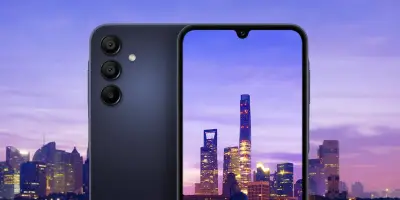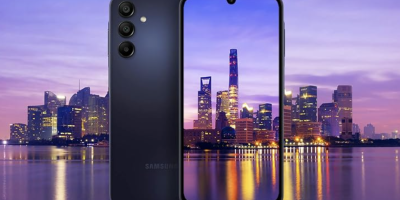 At CTIA this year, the world gawked at the Samsung Galaxy S and its amazingly beautiful SUPER AMOLED display. And it wasn’t just beautiful, it was FAST. So fast that you could say something like, “This thing really flies!” And I’m guessing that’s why the call the processor “Hummingbird”.
At CTIA this year, the world gawked at the Samsung Galaxy S and its amazingly beautiful SUPER AMOLED display. And it wasn’t just beautiful, it was FAST. So fast that you could say something like, “This thing really flies!” And I’m guessing that’s why the call the processor “Hummingbird”.
We’ll spare you the gory details, something Samsung has already offered, but oddly enough not explained/highlighted in the Press Release. Taylor from A&M noticed the claim Samsung made during their announcement event that the Galaxy S can “process a staggering 90 million triangles per second” and said “three times faster than any smartphone”.
Turns out its true. Here are the numbers of some Android Phones compared with consoles:
- Motorola Droid: TI OMAP3430 with PowerVR SGX530 = 7 million(?) triangles/sec
- Nexus One: Qualcomm QSD8×50 with Adreno 200 = 22 million triangles/sec
- iPhone 3G S: 600 MHz Cortex-A8 with PowerVR SGX535 = 28 million triangles/sec
- Samsung Galaxy S: S5PC110 with PowerVR SGX540 = 90 million triangles/sec
- PS3: 250 million triangles/sec
- Xbox 360: 500 million triangles/sec
What the heck does it mean to be able to process 90 million triangles/sec? I’m not exactly sure, but processing 90 million of anything in a second is pretty darn impressive. But for those who want the in-depth answer, look no further than the “Polygons In Computer Graphics” section of Wikipedia:
A polygon in a computer graphics (image generation) system is a two-dimensional shape that is modelled and stored within its database. A polygon can be coloured, shaded and textured, and its position in the database is defined by the co-ordinates of its vertices (corners).
Naming conventions differ from those of mathematicians:
* A simple polygon does not cross itself.
* a concave polygon is a simple polygon having at least one interior angle greater than 180°.
* A complex polygon does cross itself.Use of Polygons in Real-time imagery. The imaging system calls up the structure of polygons needed for the scene to be created from the database. This is transferred to active memory and finally, to the display system (screen, TV monitors etc) so that the scene can be viewed. During this process, the imaging system renders polygons in correct perspective ready for transmission of the processed data to the display system. Although polygons are two dimensional, through the system computer they are placed in a visual scene in the correct three-dimensional orientation so that as the viewing point moves through the scene, it is perceived in 3D.
Morphing. To avoid artificial effects at polygon boundaries where the planes of contiguous polygons are at different angle, so called “Morphing Algorithms” are used. These blend, soften or smooth the polygon edges so that the scene looks less artificial and more like the real world.
Meshed Polygons. The number of meshed polygons (“meshed” is like a fish net) can be up to twice that of free-standing unmeshed polygons, particularly if the polygons are contiguous. If a square mesh has n + 1 points (vertices) per side, there are n squared squares in the mesh, or 2n squared triangles since there are two triangles in a square. There are (n+1) 2/2n2 vertices per triangle. Where n is large, this approaches one half. Or, each vertex inside the square mesh connects four edges (lines).
Polygon Count. Since a polygon can have many sides and need many points to define it, in order to compare one imaging system with another, “polygon count” is generally taken as a triangle. When analysing the characteristics of a particular imaging system, the exact definition of polygon count should be obtained as it applies to that system as there is some flexibility in processing which causes comparisons to become non-trivial. Vertex Count. Although using this metric appears to be closer to reality it still must be taken with some salt. Since each vertex can be augmented with other attributes (such as color or normal) the amount of processing involved cannot be trivially inferred. Furthermore, the applied vertex transform is to be accounted, as well topology information specific to the system being evaluated as post-transform caching can introduce consistent variations in the expected results.
Point in polygon test. In computer graphics and computational geometry, it is often necessary to determine whether a given point P = (x0,y0) lies inside a simple polygon given by a sequence of line segments. It is known as the Point in polygon test.
Yes, why of course. Exactly what I was going to say.










DROID GPU was not the same as the 3GS?
why that 7 millions have a (?) in the side
@JAG
According to http://en.wikipedia.org/wiki/PowerVR, the SGX530 in the Droid does 14 MPolys/s @200MHz, and the SGX535 in the iPhone 3GS does 28 MPolys/s @200MHz. Polygons probably = triangles because OpenGL ES breaks all shapes down to triangles. Also keep in mind that the Droid has a lot more pixels to display than the iPhone 3GS, Droid has 409,920 (480 x 854), iPhone 3GS 153,600 (480×320). So the Droid’s GPU has a lot more work to do to display a frame.
Just to throw another number out there for comparison, the AMD Radeon 5870 GPU does 850 Million Polygons/sec.
There’s a lot more to GPU performance than polys/sec though.
ohh boy, I remember heated fanboy battles over the xbox 360 and ps3 over the whole triangle issue..
so as a android fanbot..go screw iphoney’s
According to Wikipedia, Moto Droid is 14m/sec, not 7. (SGX530 inside milestone).
But, finally, it really does 90m/sec or it’s marketing modification?
They say on Wiki that SGX540 is “twice performance of 530”, which would mean it is “only” 28m/sec.
http://en.wikipedia.org/wiki/PowerVR
How is the Nexus One’s graphic processing SLOWER than the iPhone 3GS when the phone has 75% FASTER processor?
“What the heck does it mean to be able to process 90 million triangles/sec? I’m not exactly sure, ”
–
To sum it up since the Wikipedia article didn’t get right to it. In 3D games everything is made of polygons…normally triangles. They are used to make anything from a simple wall which could be one polygon to a human head which could be 1000’s. The more polygons used in an object the more it can be made to look less boxy and jagged and more like a real life representation. The GPU has to transform the polygons when things move or camera angles change. It has to be able to update every one of them on the screen before the next frame or you’ll see areas that didn’t update. So normally if it can’t the frame is held until its done and thats what causes the drops in framerate or the lag you may see in a game. So the polygon processing count basically gives you an idea of how detailed graphics can be and how smooth the animation can be at a given detail level or polygon count.
–
This is a very simplified explanation. Just trying to make it plain.
I think the number stated by samsung is MAX theoretical performance of the chip while the numbers stated for the Droid (14MPolys) and the iphone (28 Mpolys)are REALISTIC performance values. According to Wikipedia, SGX540 has twice the performance of the SGX530 used in the Droid, that means 28 MPolys/s (equal as iPhone), but higher fill rate that the iPhone.
@Phil
So when will these 90 million triangles/sec be needed for phone use? I reckon such processing power is over the top for graphics in the OS. So this will only be benefited in 3D games I think.
Or will this also be beneficial for multitasking for example?
yup yup, above is well explained, to add to it, you can make a “ball” using 8 triangles, they’d be very big and it would be VERY “pointy” so more triangles means the quality goes way up, we all learned this concept in elementary school. to cut a good circle out of a piece of paper you make it into a square and cut the corners, the more corners you cut the rounder it gets and it starts to look like a circle and not an octagon. so more triangles means 2 things
1. MUCH better image quality at the same framerate
OR
2. MUCH better framerate using the same “quality” as other processors…
90 million is quiet an impresive number but it also means the CPU is an energy hog… the snapdragon CPU is made to be efficient, this is why the numbers are lower.
Since Samsung actually makes the processors that iphone and Nexus use … it would only be appropriate that they put their best stuff in their devices LOL.
I wonder what kind of frame rate the HTC Evo 4G has…I bet it has a staggering millions of triangles as well…either way Android is becoming a powerhouse to reckoned with. No wonder Steve Jobs is losing sleep at night and suing his little heart out.
Its this ability to process graphics that in the end will put the portable hand held game pads out of business.
@abrown it has the same CPU as the N1 so it is still very impressive, just not the most amazing one out there, it’ll still be able to handle anything for quiet sometime
Not until the get d-pads and at least 6 buttons to push:
treefq wrote on March 26, 2010
Its this ability to process graphics that in the end will put the portable hand held game pads out of business.
I was just able to draw 8 triangles in 10 seconds.
… but that was under-clocked. If I over-clock, I’m up around 12-13.
@Rob Your chart is a bit misleading – snapdragon GPU is not that much faster than that of the Droid. Qualcomm specifically states “UP TO” 22M triangles/sec while PowerVR SGX factsheet cites 7M – 140M* (for the whole family) and adds
“* Realistic, sustainable, SoC performance at 200 MHz (e.g., less than 50% shader load); peak performance
significantly higher dependent on content and operating conditions.”
Another thing I noticed is that 7M triangles/sec is the lowest value while Droid GPU is definitely not the lowest end core of the family (SGX520 is lower). That is why I think you should change the number for Droid to 14.
If you want to see that factsheet you have to register on their site (http://www.imgtec.com)
@athir LOL
@ Athir
lol i bet they were blocky too huh
All this great speed and loads of features, but no LED flash for the camera?
I wonder how many triangles can the HTC Desire can do?
same as nexus one, 22M/sec
Holy crap I can’t believe I read this far down!…
Me ain’t :D
@marty I don’t think it will be so much of a need for the power as it is about wanting higher quality games. I question just how high quality is worth it on smaller screens with no real dedicated control mechanisms. No point in looking that great if your finger is always in the way.
Since when could the xbox do 2x the graphics as the ps3.
Wow this samsung is fast like Ben johnson or roids or is it droids? i am a master on etch a sketch and can do 70 triangles per second, anyway android is kicking my soon to be delivered htcdesire# is sick all is well in my world!
Yes, but all this is irrelevant (to me) if I can’t get one. Due to the way the Nexus One is being marketed I can’t get one (already have a TMo account, and have for 10+ years) even though I’m overdue for a subsidized phone from TMo at present.
So is this going to be another Europe Only thing, leaving us the the states with 2 classes of Android phones, Nexus One and archaic trash?
Because I’m not paying $1000 for a phone, thanks anyway Sony Erickson (just in case you’re wondering why UIQ never took off) and I’m certainly NOT using my subsidy for the next 2 years for a 528 MHz processor with 48k (that’s sarcasm, but close enough) of app installation space.
OT – Guys, can anyone tell me if there is an android app that will show where another android user is using GPS. Going up to London to support a friend in the London marathon in april, and wnat to know if we can track progress via Android?
Regards
Ken………
“”Since when could the xbox do 2x the graphics as the ps3″”—–It was decided at a giant nerd smackdown at a secret location in Thailand. It was close but in the end the xbox nerds were better at gouging out eyes.
How many triangles/sec does the xperia X10 display? sorry for my english..
Its obvious ,
N1 had a screen that was WVGA ( 800 x 480 )
So it was tougher to push out textures due to the nature of the resolution .
Therefore , it might be weaker then the 3GS .
Thing is reading that makes it mean nothing to me.
Being an owner of an xbox and ps3 i still stand by that my PS3 runs games smoother and visually better than my xbox360.
So what does that mean about this phone?
I was just able to draw 10 triangles in 15 seconds.